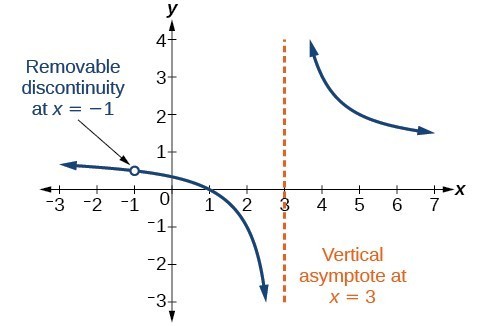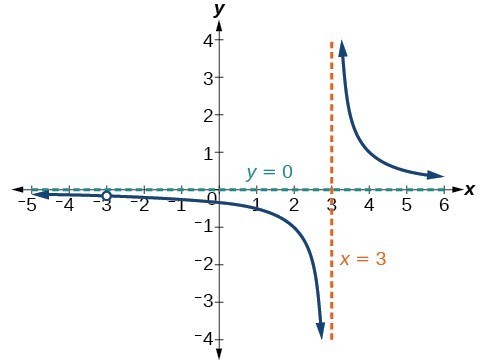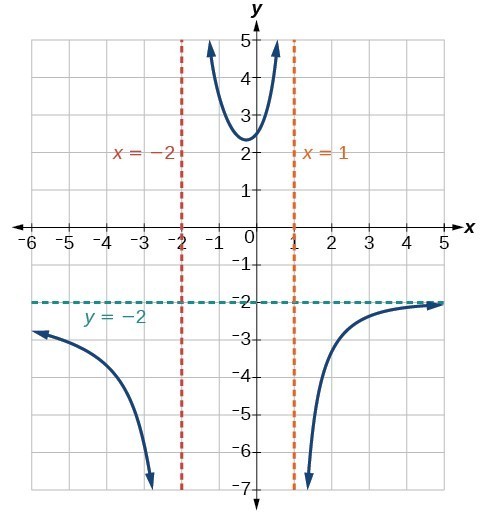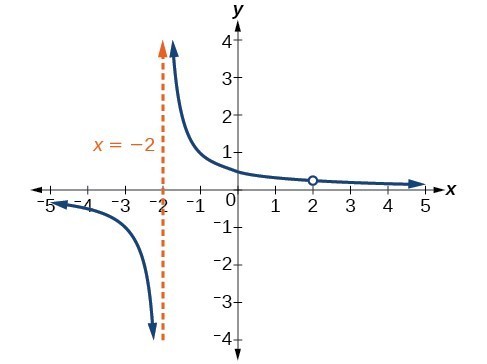Learning Outcomes
- Define the domain of a rational function given an equation.
- Use the domain of a rational function to define vertical asymptotes.
A vertical asymptote represents a value at which a rational function is undefined, so that value is not in the domain of the function. A reciprocal function (a special case of a rational function) cannot have values in its domain that cause the denominator to equal zero. In general, to find the domain of a rational function, we need to determine which inputs would cause division by zero.
A General Note: Domain of a Rational Function
The domain of a rational function includes all real numbers except those that cause the denominator to equal zero.
How To: Given a rational function, find the domain.
- Set the denominator equal to zero.
- Solve to find the values of the variable that cause the denominator to equal zero.
- The domain contains all real numbers except those found in Step 2.
Example: Finding the Domain of a Rational Function
Find the domain of [latex]f\left(x\right)=\dfrac{x+3}{{x}^{2}-9}[/latex].
recall equation solving techniques
We have learned several techniques that will enable us to solve for values of the denominator that cause it to equal zero. Techniques for solving linear and quadratic equations will help you find the domain of most of the rational functions you’ll encounter.
In the example above, solving for the values that cause [latex]x^2-9=0[/latex] can be found either by factoring or by the square root property. The denominator may also be presented in factored form, as in the example below. In this case, part of the work has already been done, and you can use the zero-product principle to find the zeros of the equation. For example,
If [latex](x-a)(x-c)=0,[/latex]
then [latex]x-a=0 \qquad[/latex] or [latex]\qquad x-c=0[/latex]
and [latex]x=a \qquad[/latex] or [latex]\qquad x=c[/latex].
You may also use the quadratic formula to solve equations in the form of [latex]ax^2+bx+c=0[/latex].
Rational functions can also have more complicated denominators, containing radicals or degrees greater than 2. In each case, equation solving techniques you’ve seen in the course will apply.
Try It
Find the domain of [latex]f\left(x\right)=\dfrac{4x}{5\left(x - 1\right)\left(x - 5\right)}[/latex].
By looking at the graph of a rational function, we can investigate its local behavior and easily see whether there are asymptotes. We may even be able to approximate their location. Even without the graph, however, we can still determine whether a given rational function has any asymptotes, and calculate their location.
Watch the following video to see more examples of finding the domain of a rational function.
Vertical Asymptotes
The vertical asymptotes of a rational function may be found by examining the factors of the denominator that are not common to the factors in the numerator. Vertical asymptotes occur at the zeros of such factors.
How To: Given a rational function, identify any vertical asymptotes of its graph.
- Factor the numerator and denominator.
- Note any restrictions in the domain of the function.
- Reduce the expression by canceling common factors in the numerator and the denominator.
- Note any values that cause the denominator to be zero in this simplified version. These are where the vertical asymptotes occur.
- Note any restrictions in the domain where asymptotes do not occur. These are removable discontinuities.
Example: Identifying Vertical Asymptotes
Find the vertical asymptotes of the graph of [latex]k\left(x\right)=\dfrac{5+2{x}^{2}}{2-x-{x}^{2}}[/latex].
Try it
Removable Discontinuities
Occasionally, a graph will contain a hole: a single point where the graph is not defined, indicated by an open circle. We call such a hole a removable discontinuity.
For example, the function [latex]f\left(x\right)=\dfrac{{x}^{2}-1}{{x}^{2}-2x - 3}[/latex] may be re-written by factoring the numerator and the denominator.
[latex]f\left(x\right)=\dfrac{\left(x+1\right)\left(x - 1\right)}{\left(x+1\right)\left(x - 3\right)}[/latex]
Notice that [latex]x+1[/latex] is a common factor to the numerator and the denominator. The zero of this factor, [latex]x=-1[/latex], is the location of the removable discontinuity. Notice also that [latex]x - 3[/latex] is not a factor in both the numerator and denominator. The zero of this factor, [latex]x=3[/latex], is the vertical asymptote.

A General Note: Removable Discontinuities of Rational Functions
A removable discontinuity occurs in the graph of a rational function at [latex]x=a[/latex] if a is a zero for a factor in the denominator that is common with a factor in the numerator. We factor the numerator and denominator and check for common factors. If we find any, we set the common factor equal to 0 and solve. This is the location of the removable discontinuity. This is true if the multiplicity of this factor is greater than or equal to that in the denominator. If the multiplicity of this factor is greater in the denominator, then there is still an asymptote at that value.
Example: Identifying Vertical Asymptotes and Removable Discontinuities for a Graph
Find the vertical asymptotes and removable discontinuities of the graph of [latex]k\left(x\right)=\dfrac{x - 2}{{x}^{2}-4}[/latex].
Try It
The rational function [latex]f\left(x\right)\ =\ \dfrac{\left(x^2-a^2\right)}{\left(x^3-\left(a+1\right)x^2+ax\right)}[/latex] needs to be graphed using an online graphing calculator. Investigate the changes in the graph for values of [latex]a[/latex] on the interval [latex][-5,5][/latex], and answer the following questions.
- For what values of [latex]a[/latex] does [latex]f(a)[/latex] represent a removable discontinuity?
- For what values of [latex]a[/latex] does the line [latex]x = a[/latex] represent a vertical asymptote?
Candela Citations
- Revision and Adaptation. Provided by: Lumen Learning. License: CC BY: Attribution
- Domain and It's Affect on Vertical Asymptotes. Authored by: Lumen Learning (with Desmos). Located at: https://www.desmos.com/calculator/sxxheguz0j. License: CC BY: Attribution
- Question ID 74565. Authored by: Nearing,Daniel, mb Lippman,David. License: CC BY: Attribution. License Terms: IMathAS Community License CC-BY + GPL
- College Algebra. Authored by: Abramson, Jay et al.. Provided by: OpenStax. Located at: http://cnx.org/contents/9b08c294-057f-4201-9f48-5d6ad992740d@5.2. License: CC BY: Attribution. License Terms: Download for free at http://cnx.org/contents/9b08c294-057f-4201-9f48-5d6ad992740d@5.2
- Ex: The Domain of Rational Functions . Authored by: James Sousa (Mathispower4u.com) . Located at: https://youtu.be/v0IhvIzCc_I. License: CC BY: Attribution



